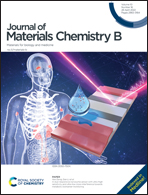Stiff and strong hydrogel tube with great mechanical properties and high stability in various solutions†
Abstract
Hydrogel tubes are widely used in fields such as artificial blood vessels, drug delivery, biomedical scaffolds and cell adhesion, yet their application is often limited by unsatisfactory mechanical properties and poor stability in various solutions. Herein, a novel hydrogel tube exhibiting a remarkable mechanical performance and stability in various solutions is prepared by introducing a dual physically cross-linked double network (DN) hydrogel matrix. The obtained hydrogel tube can withstand ∼60 N load without fracture and be stretched to over twice its original length before and after immersing in various solutions. The great mechanical properties and stability in various solutions of hydrogel tubes are due to the introduction of a dual physically cross-linked poly(acrylamide-co-acrylic acid)/carboxymethylcellulose sodium/Fe3+ DN hydrogel, which possesses high elastic modulus (3.71 MPa), fracture energy (15.4 kJ m−2), and great stability in various solutions. In addition, the hydrogel tubes with different thickness, diameters, shapes and the multiple branched hydrogel tubes can also be fabricated to enable further functionalization for application requirements. Therefore, this new type of hydrogel tube presents tremendous potential for applications in biomedical and engineering fields.



 Please wait while we load your content...
Please wait while we load your content...